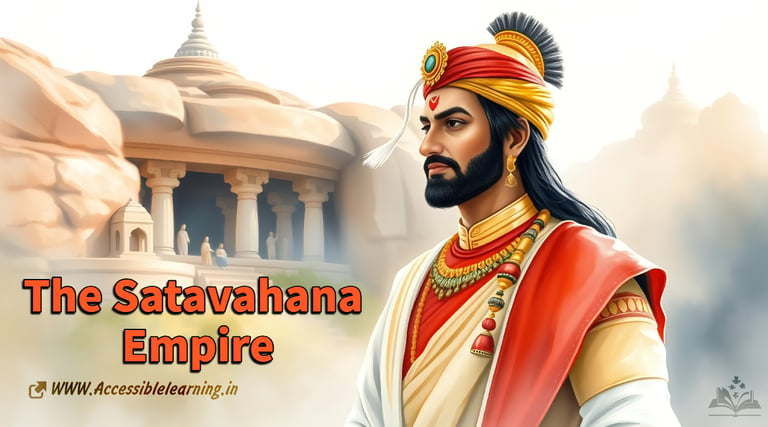
The Satavahana Dynasty: Deccan's Golden Empire (230 BCE - 220 CE)
Explore the remarkable legacy of the Satavahana dynasty, ancient India's powerful rulers who transformed the Deccan region through political innovation, international trade, and cultural patronage. This comprehensive examination reveals how these influential monarchs created a sophisticated empire that connected North and South India while establishing enduring administrative, economic, and artistic traditions that shaped the subcontinent's history.
EMPIRES/HISTORYEDUCATION/KNOWLEDGEHISTORYINDIA/BHARAT
Keshav Jha
3/20/20257 min read


The Satavahana dynasty stands as one of ancient India's most influential yet often overlooked empires. Ruling the Deccan region from approximately 230 BCE to 220 CE, these remarkable monarchs established a powerful kingdom that connected South and North India during a pivotal period of cultural and economic development. Their legacy encompasses pioneering achievements in governance, art, architecture, and international trade that continue to resonate through Indian history.
Origins and Rise to Power
The Satavahanas emerged from the political vacuum created after the decline of the Mauryan Empire in the 3rd century BCE. Initially serving as feudatories to the Mauryas, they steadily consolidated power in the Deccan Plateau. Historical records, including the Puranas and various inscriptions, identify Simuka as the dynasty's founder, though scholarly debate continues regarding the exact timing of their ascension.
Archaeological evidence suggests the Satavahanas originated in the western Deccan, specifically in modern-day Maharashtra. Their capital, Pratishthana (modern Paithan), became a thriving center of commerce and culture under their rule. The dynasty's early kings, including Krishna and Satakarni I, expanded territorial control and established administrative systems that would sustain their empire for centuries.
Territorial Expansion
Satakarni I, the third ruler of the dynasty, significantly expanded Satavahana territory through military conquests. His achievements include:
Conducting Ashvamedha sacrifices (horse rituals) that symbolized imperial sovereignty
Extending control over parts of Western India and the Konkan coast
Establishing political alliances with neighboring kingdoms
Fortifying border regions against external threats
Inscriptions from this period mention the Satavahanas as "Lords of Dakshinapatha/दक्षिणापथ के भगवान" (masters of the Southern route), highlighting their dominance over crucial trade corridors.
Golden Age Under Gautamiputra Satakarni
The Satavahana dynasty reached its zenith during the reign of Gautamiputra Satakarni (circa 86-110 CE). The Nashik prashasti (inscription) composed by his mother Gautami Balashri provides invaluable insights into his accomplishments. Under his leadership, the empire expanded significantly, encompassing territories across modern-day Maharashtra, parts of Madhya Pradesh, Andhra Pradesh, Karnataka, and Gujarat.
Gautamiputra Satakarni's military prowess enabled him to defeat the Sakas (Western Kshatrapas), reclaiming territories and restoring Satavahana prestige. His reign witnessed unprecedented administrative reforms, including improved taxation systems and agricultural developments. The inscription describes him as "the destroyer of the pride of Kshatriyas" and "the protector of the twice-born," indicating his commitment to upholding traditional social structures while pursuing political innovation.
Royal Titles and Imperial Ideology
Gautamiputra Satakarni adopted impressive royal titles that reflected Satavahana imperial ideology:
Rajaraja (King of Kings)
Ekabrahmana (Unique Brahmin)
Trisamudratoyapitavahana (One whose vehicles drink the waters of three oceans)
Saka-Yavana-Pallava-nisudana (Destroyer of Sakas, Yavanas, and Pallavas)
These titles emphasized both religious legitimacy and military accomplishments, establishing a sophisticated political theology that positioned the Satavahanas as divinely sanctioned rulers.
Administrative Structure and Governance
The Satavahanas implemented a sophisticated administrative framework that balanced central authority with regional autonomy. Their empire was divided into janapadas (provinces) governed by appointed officials known as amatyas. These provinces were further subdivided into aharas (districts) managed by local administrators.
The dynasty introduced innovative revenue systems, including:
Land revenue collection based on soil fertility and crop yields
Taxation on trade and commercial activities
Mining royalties from their rich mineral resources
Archaeological evidence suggests the Satavahanas maintained extensive records and employed a complex bureaucracy to manage their vast territories. Their governance model incorporated elements of both Mauryan centralization and regional flexibility, allowing them to rule effectively across diverse geographical and cultural landscapes.
Legal System and Social Order
The Satavahanas maintained a hierarchical social structure influenced by Brahmanical traditions while accommodating regional customs. Their legal system featured:
Royal courts presided over by the king or his representatives
Local panchayats (councils) for resolving village-level disputes
Standardized weights and measures for commercial transactions
Protection of property rights and inheritance laws
Land grants (agrahara) to Brahmins and religious institutions served both religious and administrative purposes, creating networks of loyal supporters throughout the empire.


Economic Prosperity and International Trade
The Satavahana era witnessed remarkable economic growth, transforming the Deccan into a commercial powerhouse. Their strategic location enabled them to control vital trade routes connecting North and South India, as well as maritime routes to Rome, Southeast Asia, and the Middle East.
Major ports like Kalyan, Sopara, and Bharukaccha (modern Bharuch) facilitated robust maritime commerce. The discovery of numerous Roman coins, pottery, and artifacts throughout Satavahana territories attests to their extensive international trade networks. The dynasty minted its own coins, typically featuring royal portraits and symbols, which circulated widely and facilitated commercial transactions.
Agricultural innovations, including advanced irrigation systems and water management techniques, enhanced crop yields and food security. The Satavahanas also patronized guilds (shrenis) of artisans and merchants, contributing to urban development and specialized craft production.
Economic Innovations and Industries
The Satavahanas introduced several economic innovations:
Standardized currency systems with lead, copper, and silver coins
Centralized market regulation through appointed officials
Public warehouses for grain storage and distribution
Irrigation tanks and canals for agricultural development
Archaeological excavations have revealed evidence of specialized industries throughout Satavahana territories:
Textile production centers in Ter and Kondapur
Jewelry manufacturing in Paithan and Nevasa
Pottery production in Brahmagiri and Sannati
Metallurgy and iron working in Karimnagar and Kodumanal
These industries produced both domestic goods and export commodities, contributing to the empire's economic prosperity.
Cultural Contributions and Religious Patronage
The Satavahanas embraced religious pluralism, supporting both Vedic traditions and emerging Buddhist and Jain communities. Their patronage of Buddhist establishments is particularly noteworthy, with magnificent cave complexes at Ajanta, Ellora, Karle, and Nashik serving as enduring testaments to their cultural contributions.
The Amaravati stupa, one of the largest in ancient India, flourished under Satavahana patronage. The distinctive "Amaravati School" of sculpture developed during this period, characterized by narrative relief panels and intricate decorative elements that influenced artistic traditions throughout South and Southeast Asia.
The dynasty also promoted Sanskrit learning while simultaneously supporting the development of Prakrit languages. The Gathasaptasati, a collection of Prakrit poems/प्राकृत कविताएँ attributed to King Hala, represents a significant literary achievement of the era, celebrating everyday life and human emotions.
Architectural Achievements
Satavahana architectural patronage created some of ancient India's most impressive monuments:
The Karle Caves, featuring the largest rock-cut chaitya hall in India
The Nashik Caves, with their sophisticated water management systems
The Kanheri Caves, containing over 100 rock-cut chambers
The Nagarjunakonda complex, with its elaborate stupa and monastic buildings
These structures incorporated innovative engineering techniques, including:
Advanced structural support systems
Sophisticated drainage networks
Acoustically designed meditation halls
Elaborate water cisterns and storage facilities
The artistic traditions established during this period influenced subsequent developments in Indian architecture for centuries to come.
Literary and Intellectual Achievements
Beyond the Gathasaptasati, the Satavahana era produced significant literary and intellectual contributions:
Commentaries on Dharmasastras (legal texts) and Vedic literature
Buddhist canonical texts and commentaries
Early works on astronomy and mathematics
Medical treatises building on Ayurvedic traditions
The Satavahana court attracted scholars from throughout the subcontinent, fostering intellectual exchange and cultural synthesis between diverse traditions.


Decline and Legacy
By the early 3rd century CE, the Satavahana empire began to fragment due to several factors:
Increasing pressure from the Vakatakas and Western Kshatrapas
Internal succession disputes
The rise of regional powers within their territories
Changing trade patterns and economic challenges
Possible environmental factors affecting agricultural productivity
The later Satavahana rulers, including Yajna Sri Satakarni, struggled to maintain imperial cohesion. Eventually, the empire dissolved into smaller kingdoms, including the Ikshvakus in Andhra and the Abhiras in western India.
Despite their political decline, the Satavahana legacy endured through their administrative innovations, cultural patronage, and economic systems. They established patterns of governance that influenced subsequent dynasties and fostered cultural synthesis between North and South Indian traditions.
Successor States and Enduring Influence
Several significant kingdoms emerged from the former Satavahana territories:
The Ikshvakus in Andhra Pradesh continued their artistic and religious patronage
The Vakatakas in Maharashtra maintained administrative systems
The Kadambas in Karnataka preserved aspects of Satavahana court culture
The Pallavas in Tamil Nadu adapted and developed Satavahana architectural traditions
These successor states preserved and transformed Satavahana cultural and political legacies, ensuring their continued influence on Indian civilization.
Archaeological Evidence and Historical Sources
Our understanding of the Satavahanas derives from diverse sources:
Inscriptions at Buddhist cave sites like Nashik, Karle, and Kanheri
Numismatic evidence from their extensive coinage
Archaeological excavations at sites like Paithan, Ter, and Kondapur
References in classical Western sources, including the Periplus of the Erythraean Sea
Mentions in various Puranas and Buddhist texts
Recent archaeological discoveries continue to enhance our knowledge of this remarkable dynasty. Excavations at Kotilingala, Veerapuram, and other sites have yielded valuable artifacts and structural remains that provide insights into Satavahana urban planning, architectural techniques, and material culture.
Recent Archaeological Findings
Modern archaeological techniques have revealed new dimensions of Satavahana civilization:
Ground-penetrating radar surveys at Paithan have identified previously unknown urban structures
Chemical analysis of pottery from Ter has documented trade connections with distant regions
Underwater archaeology near coastal sites has revealed evidence of maritime infrastructure
Genetic studies of human remains provide insights into population movement and demographics
Paleobotanical analysis offers information about agricultural practices and dietary patterns
These interdisciplinary approaches continue to transform our understanding of the Satavahana period, revealing the complexity and sophistication of their civilization.
Challenges in Satavahana Historiography
Scholars face several challenges in reconstructing Satavahana history:
Limited textual sources compared to contemporaneous North Indian dynasties
Difficulties in establishing precise chronology and royal succession
Regional variations in material culture and administrative practices
Interpretive challenges in analyzing religious and cultural symbolism
Gaps in archaeological evidence due to subsequent construction and natural processes
Despite these challenges, ongoing research continues to illuminate the significance of the Satavahana dynasty in ancient Indian history.
Women in Satavahana Society
Unlike many ancient Indian dynasties, the Satavahanas provide significant evidence for the prominent role of women, particularly royal women, in political and religious affairs:
Naganika, wife of King Satakarni I, commissioned inscriptions in her own name at Naneghat
Gautami Balashri, mother of Gautamiputra Satakarni, authored the Nashik prashasti
Several royal women appear as donors in Buddhist cave inscriptions
Female figures feature prominently in Satavahana art and iconography
These sources suggest that Satavahana women, at least among the elite classes, enjoyed considerable status and authority. Female religious patronage, in particular, appears to have been a significant aspect of Satavahana political and cultural life.
Technological and Scientific Advancements
The Satavahana period witnessed important technological and scientific developments:
Advanced metallurgical techniques for coin production and sculpture
Sophisticated water management systems, including reservoirs and step-wells
Astronomical observations and calendrical calculations
Medicinal preparations and pharmaceutical knowledge
Agricultural innovations, including new crop varieties and cultivation methods
These advancements supported the empire's economic prosperity and cultural achievements, demonstrating the Satavahanas' commitment to practical knowledge and innovation.
The Satavahana dynasty represents a pivotal chapter in ancient Indian history, bridging the gap between the Mauryan and Gupta periods. Their achievements in governance, economic development, and cultural patronage laid the foundations for subsequent South Indian kingdoms. By fostering trade networks, supporting religious diversity, and promoting artistic innovation, the Satavahanas created a legacy that transcended their political boundaries.
Their story exemplifies the remarkable resilience and adaptability of ancient Indian civilizations. As archaeological research continues to uncover new evidence, our appreciation for the Satavahanas' contributions to India's rich historical tapestry will undoubtedly continue to grow, revealing further insights into this transformative period of South Asian history.
The Satavahana dynasty stands as a testament to the complexity and sophistication of ancient Indian political systems, demonstrating how regional powers could establish enduring cultural and economic frameworks that influenced subsequent civilizations throughout the subcontinent and beyond.
Subscribe To Our Newsletter
All © Copyright reserved by Accessible-Learning Hub
| Terms & Conditions
Knowledge is power. Learn with Us. 📚


